What Is Chalky? Investigating Consumer Language and Perception of Fine Particles in Beverages Containing Pea and Potato Starch
Abstract
1. Introduction
2. Materials and Methods
2.1. Ethics Statement
2.2. Participant Recruitment and Consent
2.3. Sample Preparation
2.4. Design and Rationale
2.5. Dispersion Viscosity Measurement
2.6. Data Analysis
3. Results
3.1. Participants Characteristics
3.2. Effect of Particle Size, Concentration, and Xanthan Content on Chalky Ratings
3.3. Salivary Flow Rate Effect on Chalky Ratings
3.4. Chalky Ratings over Time
3.5. Decorrelation Analysis of Chalky and Other Similar Perceptions on Fine Particles
4. Discussion
5. Conclusions
Supplementary Materials
Author Contributions
Funding
Institutional Review Board Statement
Informed Consent Statement
Data Availability Statement
Acknowledgments
Conflicts of Interest
References
- Guinard, J.-X.; Mazzucchelli, R. The sensory perception of texture and mouthfeel. Trends Food Sci. Technol. 1996, 7, 213–219. [Google Scholar] [CrossRef]
- Allgeyer, L.C.; Miller, M.J.; Lee, S.-Y. Sensory and microbiological quality of yogurt drinks with prebiotics and probiotics. J. Dairy Sci. 2010, 93, 4471–4479. [Google Scholar] [CrossRef] [PubMed]
- Bull, S.P.; Hong, Y.; Khutoryanskiy, V.V.; Parker, J.K.; Faka, M.; Methven, L. Whey protein mouth drying influenced by thermal denaturation. Food Qual. Prefer. 2017, 56, 233–240. [Google Scholar] [CrossRef]
- Chakraborty, P.; Witt, T.; Harris, D.; Ashton, J.; Stokes, J.R.; Smyth, H.E. Texture and mouthfeel perceptions of a model beverage system containing soluble and insoluble oat bran fibres. Food Res. Int. 2019, 120, 62–72. [Google Scholar] [CrossRef] [PubMed]
- Drake, M.A.; Chen, X.Q.; Tamarapu, S.; Leenanon, B. Soy Protein Fortification Affects Sensory, Chemical, and Microbiological Properties of Dairy Yogurts. J. Food Sci. 2000, 65, 1244–1247. [Google Scholar] [CrossRef]
- Kuntz, D.A.; Nelson, A.I.; Steinberg, M.P.; Wei, L.S. Control of Chalkiness in Soymilk. J. Food Sci. 1978, 43, 1279–1283. [Google Scholar] [CrossRef]
- Rubico, S.M.; Resurreccion, A.V.A.; Frank, J.F.; Beuchat, L.R. Suspension Stability, Texture, and Color of High Temperature Treated Peanut Beverage. J. Food Sci. 1987, 52, 1676–1679. [Google Scholar] [CrossRef]
- Brückner-Gühmann, M.; Banovic, M.; Drusch, S. Towards an increased plant protein intake: Rheological properties, sensory perception and consumer acceptability of lactic acid fermented, oat-based gels. Food Hydrocoll. 2019, 96, 201–208. [Google Scholar] [CrossRef]
- Liu, J.; Bech, A.C.; Stolzenbach Waehrens, S.; Bredie, W.L.P. Perception and liking of yogurts with different degrees of granularity in relation to ethnicity, preferred oral processing and lingual tactile acuity. Food Qual. Prefer. 2021, 90, 104158. [Google Scholar] [CrossRef]
- Shewan, H.M.; Stokes, J.R.; Smyth, H.E. Influence of particle modulus (softness) and matrix rheology on the sensory experience of ‘grittiness’ and ‘smoothness’. Food Hydrocoll. 2020, 103, 105662. [Google Scholar] [CrossRef]
- Singh, G. Sensory and Consumer Evaluation of Lucuma Powder as an Ingredient for Ice Cream in the United States. Master’s Thesis, Kansas State University, Manhattan, KS, USA, 2021. Available online: https://hdl.handle.net/2097/41879 (accessed on 15 January 2024).
- Alting, A.C.; van de Velde, F.; Kanning, M.W.; Burgering, M.; Mulleners, L.; Sein, A.; Buwalda, P. Improved creaminess of low-fat yoghurt: The impact of amylomaltase-treated starch domains. Food Hydrocoll. 2009, 23, 980–987. [Google Scholar] [CrossRef]
- Chojnicka-Paszun, A.; Doussinault, S.; de Jongh, H.H.J. Sensorial analysis of polysaccharide–gelled protein particle dispersions in relation to lubrication and viscosity properties. Food Res. Int. 2014, 56, 199–210. [Google Scholar] [CrossRef]
- Ciron, C.I.E.; Gee, V.L.; Kelly, A.L.; Auty, M.A. Effect of microfluidization of heat-treated milk on rheology and sensory properties of reduced fat yoghurt. Food Hydrocoll. 2011, 25, 1470–1476. [Google Scholar] [CrossRef]
- Santagiuliana, M.; Broers, L.; Marigómez, I.S.; Stieger, M.; Piqueras-Fiszman, B.; Scholten, E. Strategies to compensate for undesired gritty sensations in foods. Food Qual. Prefer. 2020, 81, 103842. [Google Scholar] [CrossRef]
- Leksrisompong, P.; Whitson, M.; Truong, V.; Drake, M. Sensory Attributes and Consumer Acceptance of Sweet Potato Cultivars with Varying Flesh Colors. J. Sens. Stud. 2012, 27, 59–69. [Google Scholar] [CrossRef]
- van der Stelt, A.J.; Mehring, P.; Corbier, C.; van Eijnatten, E.J.M.; Withers, C. A “mouthfeel wheel” terminology for communicating the mouthfeel attributes of medical nutrition products (MNP). Food Qual. Prefer. 2020, 80, 103822. [Google Scholar] [CrossRef]
- Withers, C.A.; Lewis, M.J.; Gosney, M.A.; Methven, L. Potential sources of mouth drying in beverages fortified with dairy proteins: A comparison of casein- and whey-rich ingredients. J. Dairy Sci. 2014, 97, 1233–1247. [Google Scholar] [CrossRef] [PubMed]
- Tyle, P. Effect of size, shape and hardness of particles in suspension on oral texture and palatability. Acta Psychol. 1993, 84, 111–118. [Google Scholar] [CrossRef]
- Imai, E.; Hatae, K.; Shimada, A. Oral Perception of Grittiness: Effect of Particle Size and Concentration of the Dispersed Particles and the Dispersion Medium. J. Texture Stud. 1995, 26, 561–576. [Google Scholar] [CrossRef]
- Imai, E.; Saito, K.; Hatakeyama, M.; Hatae, K.; Shimada, A. Effect of Physical Properties of Food Particles on the Degree of Graininess Perceived in the Mouth. J. Texture Stud. 1999, 30, 59–88. [Google Scholar] [CrossRef]
- Mosca, A.C.; Chen, J. Food-saliva interactions: Mechanisms and implications. Trends Food Sci. Technol. 2017, 66, 125–134. [Google Scholar] [CrossRef]
- Guinard, J.-X.; Zoumas-Morse, C.; Walchak, C. Relation Between Parotid Saliva Flow and Composition and the Perception of Gustatory and Trigeminal Stimuli in Foods. Physiol. Behav. 1997, 63, 109–118. [Google Scholar] [CrossRef] [PubMed]
- Engelen, L.; de Wijk, R.A.; Prinz, J.F.; Janssen, A.M.; van der Bilt, A.; Weenen, H.; Bosman, F. A comparison of the effects of added saliva, α-amylase and water on texture perception in semisolids. Physiol. Behav. 2003, 78, 805–811. [Google Scholar] [CrossRef] [PubMed]
- Engelen, L.; van den Keybus, P.A.M.; de Wijk, R.A.; Veerman, E.C.I.; Amerongen, A.V.N.; Bosman, F.; Prinz, J.F.; van der Bilt, A. The effect of saliva composition on texture perception of semi-solids. Arch. Oral Biol. 2007, 52, 518–525. [Google Scholar] [CrossRef] [PubMed]
- Fleming, E.E.; Ziegler, G.R.; Hayes, J.E. Salivary protein levels as a predictor of perceived astringency in model systems and solid foods. Physiol. Behav. 2016, 163, 56–63. [Google Scholar] [CrossRef] [PubMed]
- Horne, J.; Hayes, J.; Lawless, H.T. Turbidity as a Measure of Salivary Protein Reactions with Astringent Substances. Chem. Senses 2002, 27, 653–659. [Google Scholar] [CrossRef] [PubMed]
- Khramova, D.S.; Popov, S.V. A secret of salivary secretions: Multimodal effect of saliva in sensory perception of food. Eur. J. Oral Sci. 2022, 130, e12846. [Google Scholar] [CrossRef]
- Muñoz-González, C.; Feron, G.; Canon, F. Main effects of human saliva on flavour perception and the potential contribution to food consumption. Proc. Nutr. Soc. 2018, 77, 423–431. [Google Scholar] [CrossRef] [PubMed]
- Ma, K.K.; Madhavan, A.; Etter, N.M.; Hopfer, H.; Hayes, J.E. Texture term usage and hedonic ratings in two age-diverse cohorts of Americans. J. Texture Stud. 2023, 54, 860–871. [Google Scholar] [CrossRef]
- Methven, L.; Rahelu, K.; Economou, N.; Kinneavy, L.; Ladbrooke-Davis, L.; Kennedy, O.B.; Mottram, D.S.; Gosney, M.A. The effect of consumption volume on profile and liking of oral nutritional supplements of varied sweetness: Sequential profiling and boredom tests. Food Qual. Prefer. 2010, 21, 948–955. [Google Scholar] [CrossRef]
- Bots, C.P.; Brand, H.S.; Veerman, E.C.I.; van Amerongen, B.M.; Amerongen, A.V.N. Preferences and saliva stimulation of eight different chewing gums. Int. Dent. J. 2004, 54, 143–148. [Google Scholar] [CrossRef]
- Hayes, J.E.; Allen, A.L.; Bennett, S.M. Direct comparison of the generalized visual analog scale (gVAS) and general labeled magnitude scale (gLMS). Food Qual. Prefer. 2013, 28, 36–44. [Google Scholar] [CrossRef]
- Bartoshuk, L.M.; Duffy, V.B.; Green, B.G.; Hoffman, H.J.; Ko, C.-W.; Lucchina, L.A.; Marks, L.E.; Snyder, D.J.; Weiffenbach, J.M. Valid across-group comparisons with labeled scales: The gLMS versus magnitude matching. Physiol. Behav. 2004, 82, 109–114. [Google Scholar] [CrossRef]
- Bates, D.; Maechler, M.; Bolker, B.; Walker, S. Fitting Linear Mixed-Effects Models Using {lme4}. J. Stat. Softw. 2015, 67, 1–48. [Google Scholar] [CrossRef]
- Lenth, R.V. emmeans: Estimated Marginal Means, aka Least-Squares Means, R Package Version 1.8.4-1; CRAN.R-project.org: Vienna, Austria, 2023. Available online: https://CRAN.R-project.org/package=emmeans (accessed on 15 January 2024).
- Ben-Shachar, M.S.; Lüdecke, D.; Makowski, D. Effectsize: Estimation of Effect Size Indices and Standardized Parameters. J. Open Source Softw. 2020, 5, 2815. [Google Scholar] [CrossRef]
- Lawless, H.T.; Corrigan, C.J. Semantics of Astringency. In Olfaction and Taste XI; Kurihara, K., Suzuki, N., Ogawa, H., Eds.; Springer: Tokyo, Japan, 1994; pp. 288–292. [Google Scholar] [CrossRef]
- Husson, F.; Le, S.; Cadoret, M. SensoMineR: Sensory Data Analysis, R Package Version 1.26; CRAN.R-project.org: Vienna, Austria, 2020. Available online: https://CRAN.R-project.org/package=SensoMineR (accessed on 15 January 2024).
- Lemon, J. Plotrix: A package in the red light district of R. R-News 2006, 6, 8–12. [Google Scholar]
- Slowikowski, K. ggrepel: Automatically Position Non-Overlapping Text Labels with “ggplot2”, R Package Version 0.9.3; CRAN.R-project.org: Vienna, Austria, 2023.
- Wickham, H. ggplot2: Elegant Graphics for Data Analysis; Springer: New York, NY, USA, 2016; Available online: https://ggplot2.tidyverse.org (accessed on 15 January 2024).
- Nolden, A.A.; Hayes, J.E. Perceptual Qualities of Ethanol Depend on Concentration, and Variation in These Percepts Associates with Drinking Frequency. Chemosens. Percept. 2015, 8, 149–157. [Google Scholar] [CrossRef] [PubMed]
- Gacula, M.; Rutenbeck, S. Sample size in consumer test and descriptive analysis. J. Sens. Stud. 2006, 21, 129–145. [Google Scholar] [CrossRef]
- Laiho, S.; Williams, R.P.W.; Poelman, A.; Appelqvist, I.; Logan, A. Effect of whey protein phase volume on the tribology, rheology and sensory properties of fat-free stirred yoghurts. Food Hydrocoll. 2017, 67, 166–177. [Google Scholar] [CrossRef]
- Chaffee, O.; Laura Montero, M.; Keast, R.; Ross, C.F. Oral acuity, particle size sensitivity, and food texture preferences in an older adult population. Food Qual. Prefer. 2023, 112, 105031. [Google Scholar] [CrossRef]
- Engelen, L.; de Wijk, R.A.; Prinz, J.F.; Janssen, A.M.; Weenen, H.; Bosman, F. The effect of oral and product temperature on the perception of flavor and texture attributes of semi-solids. Appetite 2003, 41, 273–281. [Google Scholar] [CrossRef] [PubMed]
- Olarte Mantilla, S.M.; Shewan, H.M.; Shingleton, R.; Hort, J.; Stokes, J.R.; Smyth, H.E. Oral physiology, sensory acuity, product experience and personality traits impact consumers’ ability to detect particles in yoghurt. Food Qual. Prefer. 2022, 96, 104391. [Google Scholar] [CrossRef]
- Withers, C.; Barnagaud, C.; Mehring, P.; Ferris, S.; Thomson, D.M.H. Adapting and enhancing sequential profiling to understand the effects of successive ingestion, using the sensory characteristics of high intensity sweeteners as a case study. Food Qual. Prefer. 2016, 47, 139–147. [Google Scholar] [CrossRef]
- Affoo, R.H.; Foley, N.; Garrick, R.; Siqueira, W.L.; Martin, R.E. Meta-Analysis of Salivary Flow Rates in Young and Older Adults. J. Am. Geriatr. Soc. 2015, 63, 2142–2151. [Google Scholar] [CrossRef] [PubMed]
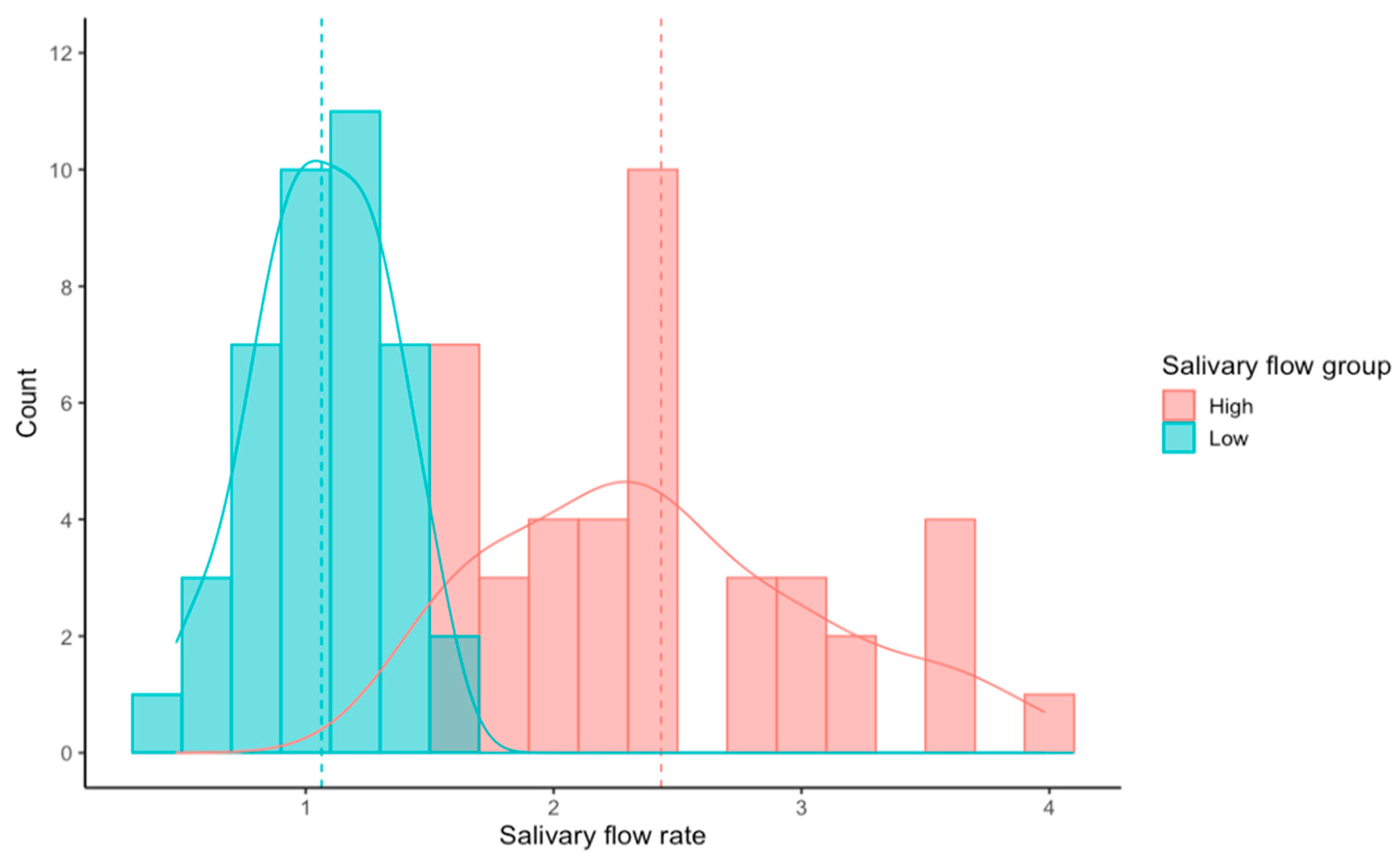
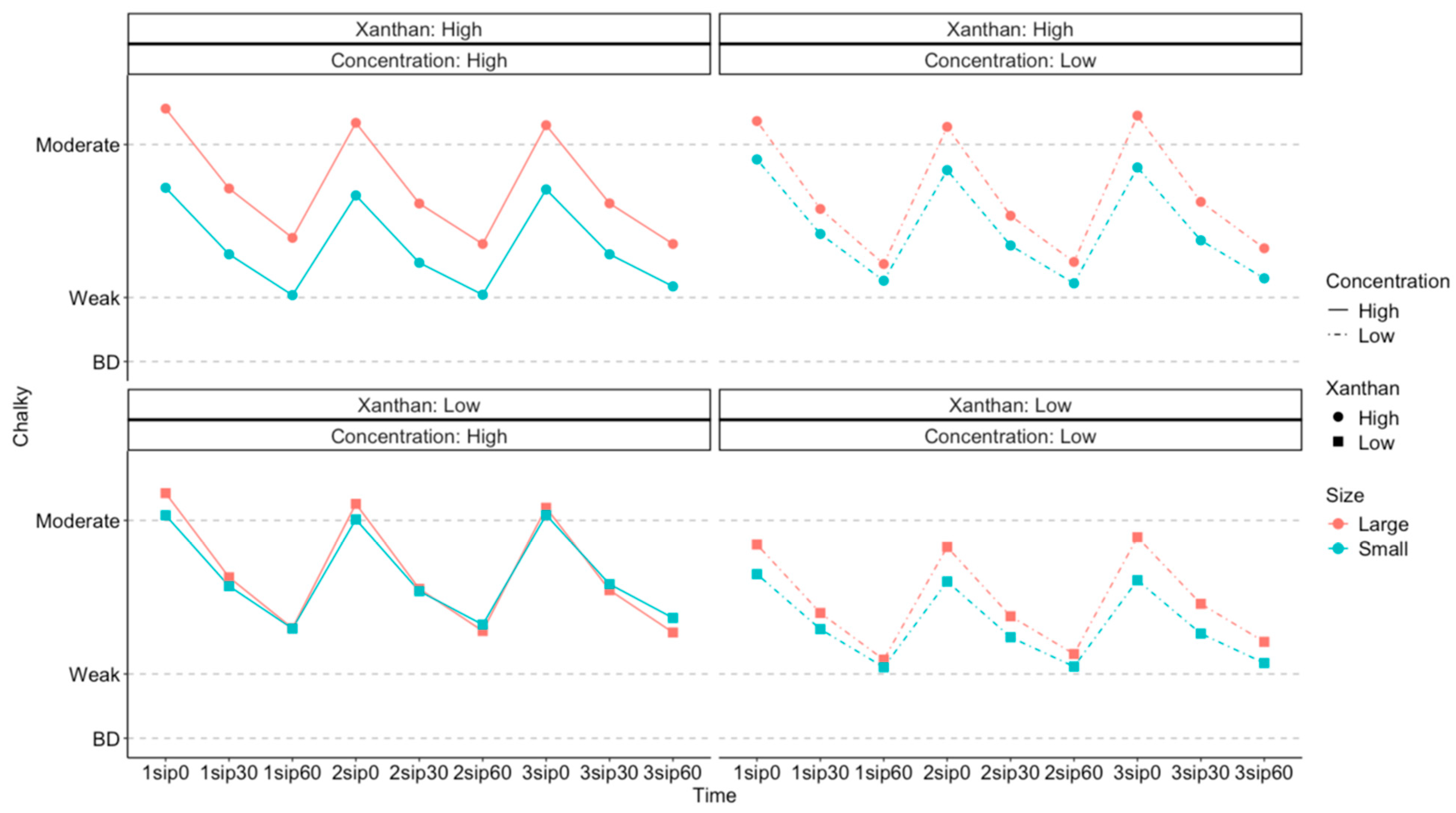
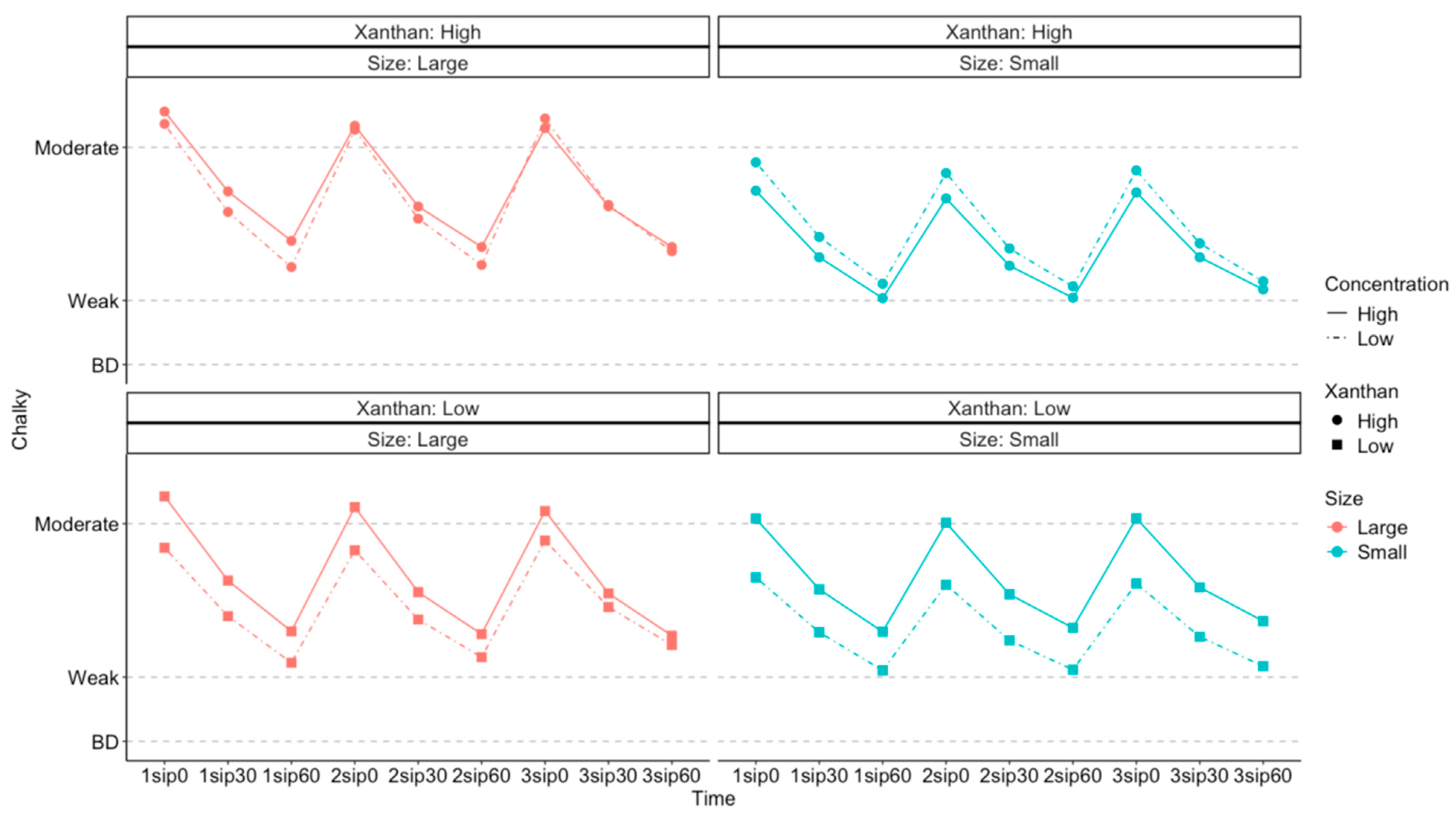
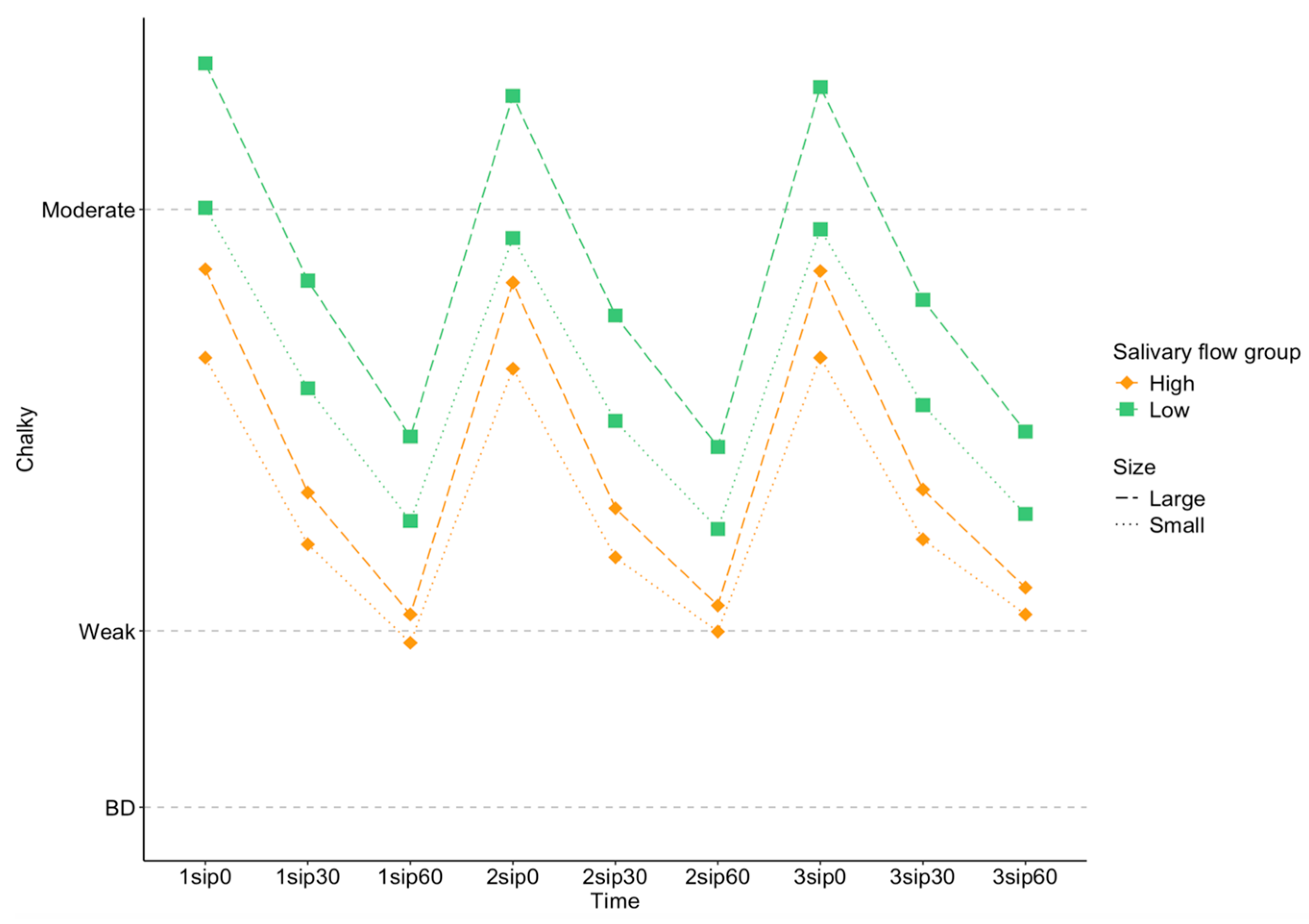
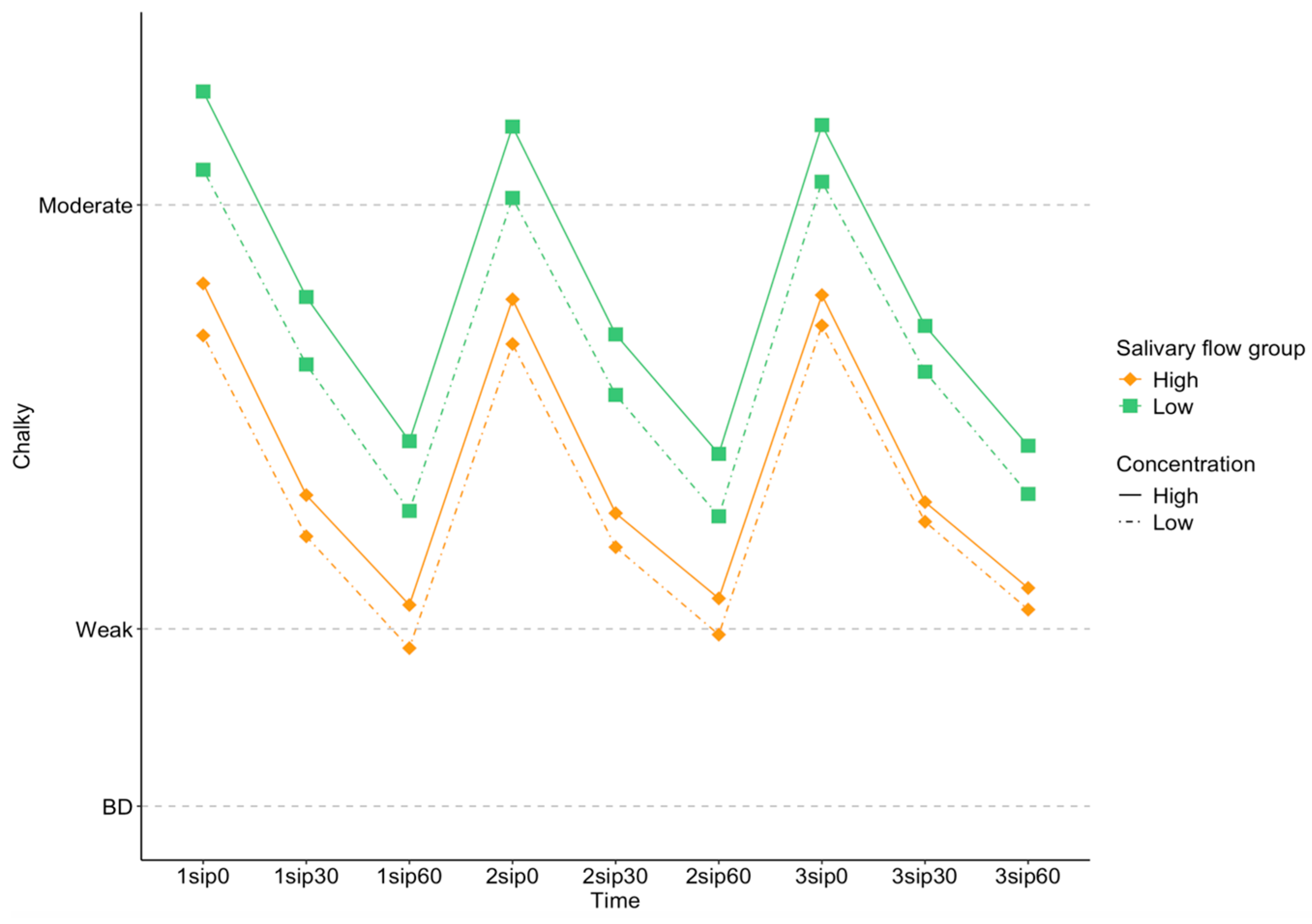
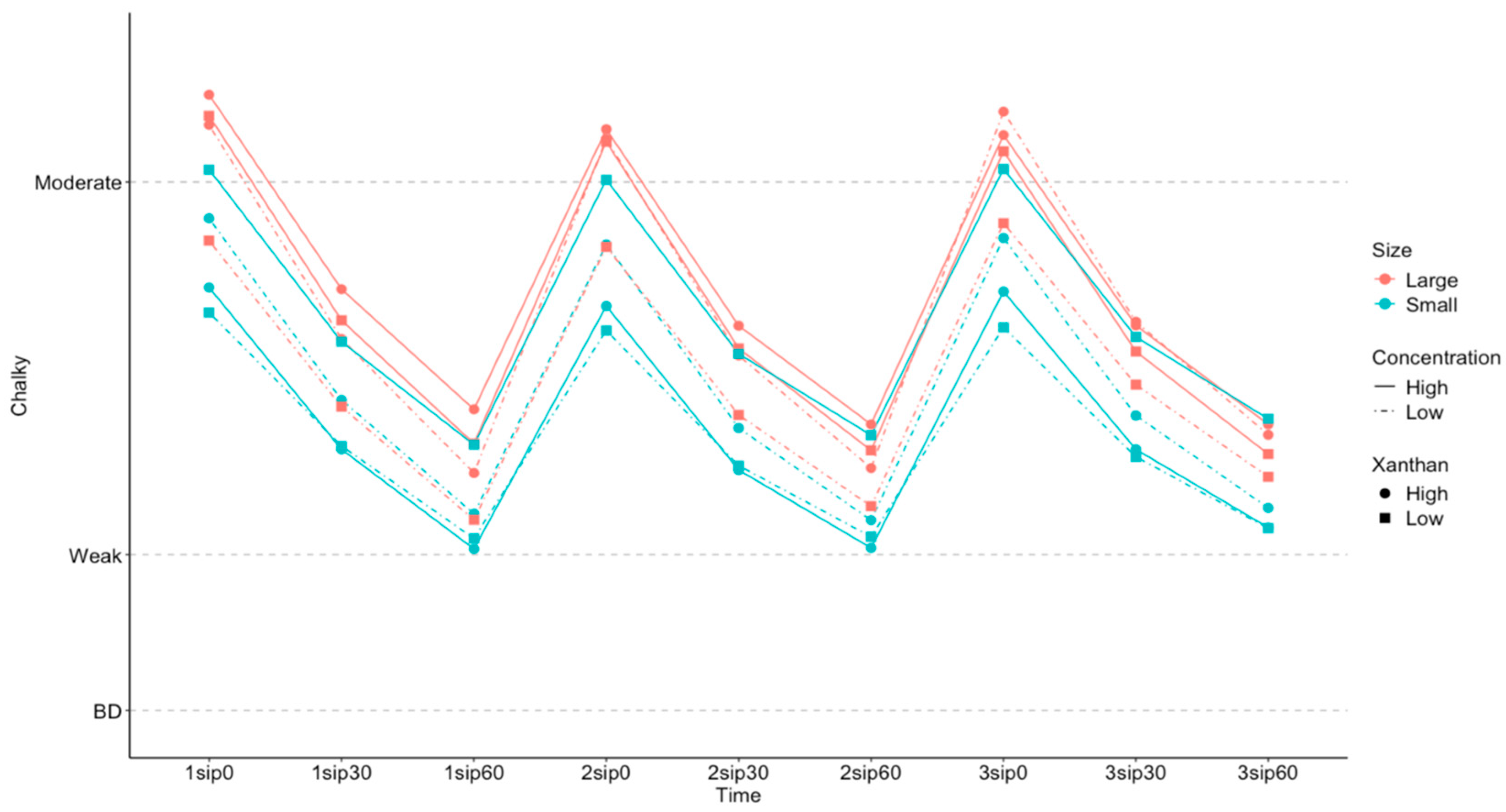
| Type of Starch | Starch Concentration (w/v%) | Xanthan Gum (w/v%) | Aspartame (w/v%) | Vanillin (w/v%) | Dispersion Viscosity (Pa.s at 1/s) |
|---|---|---|---|---|---|
| Pea | 10 | 0.075 | 0.0124 | 0.1 | 0.07 0.01 |
| Potato | 10 | 0.075 | 0.0124 | 0.1 | 0.08 0.00 |
| Pea | 20 | 0.075 | 0.0124 | 0.1 | 0.08 0.00 |
| Potato | 20 | 0.075 | 0.0124 | 0.1 | 0.11 0.01 |
| Pea | 10 | 0.15 | 0.0124 | 0.1 | 0.41 0.04 |
| Potato | 10 | 0.15 | 0.0124 | 0.1 | 0.44 0.02 |
| Pea | 20 | 0.15 | 0.0124 | 0.1 | 0.45 0.04 |
| Potato | 20 | 0.15 | 0.0124 | 0.1 | 0.55 0.02 |
| Characteristics | Mean ± SD |
|---|---|
| Gender (32 men, 49 women) | |
| Age (years, n = 82) | 41.7 ± 14.1 |
| Saliva group | |
| High salivary flow (n = 41, g per min) | 2.4 ± 0.7 |
| Low salivary flow (n = 41, g per min) | 1.1 ± 0.3 |
| Chalky | Powdery | Sandy | Gritty | Mouthdrying | |
|---|---|---|---|---|---|
| Powdery | 0.99 | ||||
| Residual Mouthcoating | 0.99 | 1.00 | 0.93 | 0.93 | 0.93 |
| Mouthdrying | 0.93 | 0.91 | 0.86 | 0.83 | |
| Gritty | 0.90 | 0.94 | 0.99 | ||
| Sandy | 0.90 | 0.94 |
Disclaimer/Publisher’s Note: The statements, opinions and data contained in all publications are solely those of the individual author(s) and contributor(s) and not of MDPI and/or the editor(s). MDPI and/or the editor(s) disclaim responsibility for any injury to people or property resulting from any ideas, methods, instructions or products referred to in the content. |
© 2024 by the authors. Licensee MDPI, Basel, Switzerland. This article is an open access article distributed under the terms and conditions of the Creative Commons Attribution (CC BY) license (https://creativecommons.org/licenses/by/4.0/).
Share and Cite
Ma, K.K.; Ziegler, G.R.; Hopfer, H.; Hayes, J.E. What Is Chalky? Investigating Consumer Language and Perception of Fine Particles in Beverages Containing Pea and Potato Starch. Foods 2024, 13, 1852. https://doi.org/10.3390/foods13121852
Ma KK, Ziegler GR, Hopfer H, Hayes JE. What Is Chalky? Investigating Consumer Language and Perception of Fine Particles in Beverages Containing Pea and Potato Starch. Foods. 2024; 13(12):1852. https://doi.org/10.3390/foods13121852
Chicago/Turabian StyleMa, Kai Kai, Gregory R. Ziegler, Helene Hopfer, and John E. Hayes. 2024. "What Is Chalky? Investigating Consumer Language and Perception of Fine Particles in Beverages Containing Pea and Potato Starch" Foods 13, no. 12: 1852. https://doi.org/10.3390/foods13121852
APA StyleMa, K. K., Ziegler, G. R., Hopfer, H., & Hayes, J. E. (2024). What Is Chalky? Investigating Consumer Language and Perception of Fine Particles in Beverages Containing Pea and Potato Starch. Foods, 13(12), 1852. https://doi.org/10.3390/foods13121852





